Total
Legal Accounting 3
SECTION
7.1.4 - PASSWORDS
USAGE: To change passwords and other user attributes.
DISCUSSION: T.L.A. contains a
high-level security password system. Each user must log-in under their assigned
user-code.
Each user-code
has an associated password. This password is encrypted
by T.L.A. via non-reversible algorithm and stored on disk along with its
respective user-code. Both items must be known before the user may
successful log-in to T.L.A.. Each user may change their password, and are in
fact encouraged to do so, to maintain security. The audit trail prints the user-code
on each line so that it is possible to track any entry back to a
specific user as well as the time and date that it was created. Furthermore,
each time a user logs-on or logs-off, an entry is made in the audit trail. This
gives the system supervisor an overview of computer usage, even for
the users who have logged-in without entering any transactions or
modifications, eg. just enquiries.
T.L.A. creates a special USER-CODE. This is the
supervisory, or top-level, log-in code. It always has the name SUPERVISOR. Only SUPERVISOR may create, deleted or,
modify user-codes. Once a user has been assigned a code, they may change their own
password. SUPERVISOR can change anyone's
password, as well as its own. SUPERVISOR also has facilities to
allow or disallow access to any menu option for any user, accept SUPERVISOR itself. SUPERVISOR always has access to all
facilities.
SUPERVISOR has absolute discretion to
change and rearrange facilities on the system. It is thus imperative to keep SUPERVISOR's password secret. It is also necessary to change
it regularly if you suspect that it is known and is being used by unauthorised
personnel.
There are no facilities to change or recover SUPERVISOR's password if it has been forgotten.
It is recommended that you always use T.L.A. via a user-code
other than SUPERVISOR. Keep the supervisory log-in for special system
maintenance only and keep SUPERVISOR's password in a safe place,
in case it is forgotten.
The PASSWORD MAINTENANCE option is
accessed by pressing 3 on the SYSTEM PARAMETERS MENU.
CHANGING
YOUR PASSWORD
Upon choosing this option you will first be asked
for your existing password. This stops unauthorised persons from changing your
password if you forget to log-off when you leave your terminal. The screen will
display as follows:
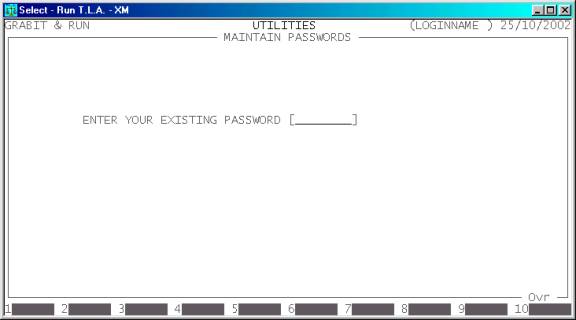
Note that at no stage will the password be display.
All that ever appears is a string of asterisks. This stops anyone else seeing
your password over your shoulder. However, it also means that you must enter
your password blind. If your password
requires upper- and lower-case characters, enter it carefully, otherwise it
will be rejected. If you do not enter the correct password (including case) you
will be returned to the SYSTEM OPTIONS MENU.
Having entered your current password, if you are not
SUPERVISOR, you will be asked to enter
your new password. As a check, the computer will ask you to re-enter your new
password. The screen looks as follows:
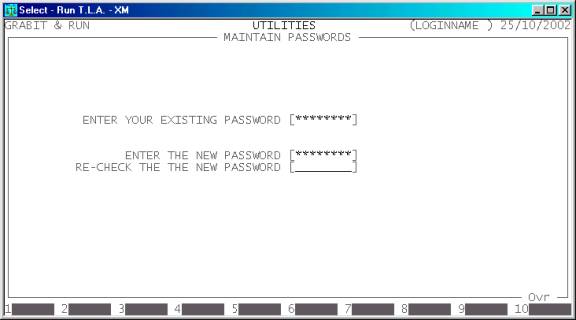
Once you have entered, and verified, the new
password, the files are updated. Your new password becomes effective
immediately.
Changing passwords as SUPERVISOR.
As with other user-codes, SUPERVISOR is first asked for its existing password. This
precaution is vital in case you have already logged-in and have left your
terminal unattended. Any unauthorised person attempting to use the password
routine would then be blocked because they would not know SUPERVISORS's password.
Having entered SUPERVISOR's password, the screen will ask two questions. The
screen will appear as follows:
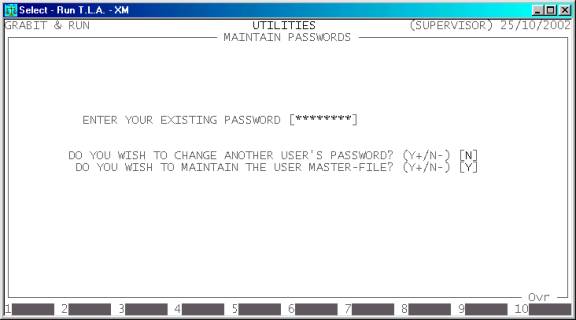
If you answer Y to the first question, the
computer will ask:
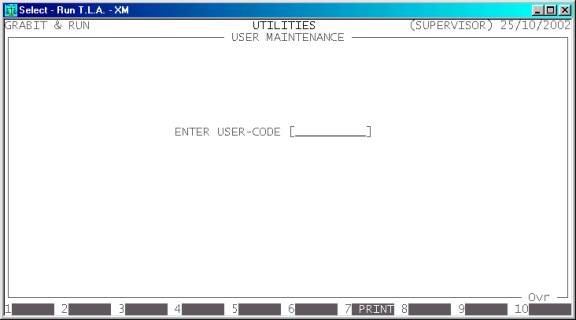
Enter the user-code of the user whose password you
wish to change. As SUPERVISOR, you do not need to know
the user's existing password. (This is very useful if the user has forgotten
their password or you wish to temporarily lock out a user.) The computer will
then ask you to enter and confirm the new password. After this you will be
returned to the SYSTEM UTILITIES MENU.
If you had entered N to
both questions (above) you will be able to change SUPERVISOR's password. The procedure is the same as for any
other user, see above.
Maintaining user attributes
This facility only exists if you log-in as SUPERVISOR. To enter the function, you must answer Y to the second question, above. You will be transferred to the USER MAINTENANCE program where the
first thing you will be asked for is a user-code. This is the user-code of the
user you wish to set attributes for. It must not be SUPERVISOR itself as the supervisor always has all options
available. If you enter a user-code that does not currently exits, you will be
asked if you wish to create the new user. When you create a new code, you will
need to also supply an initial password, eg. PASS.
The user can then change their password to one they might prefer, if required.
A user-code can be any string of
letters and/or numbers in upper- or lower-case. The user-code may be up to 10
characters long. It must not contain embedded spaces or start with a space.
A password can be any string of up to
8 characters. The password cannot be left blank but may include embedded
spaces. For maximum security, passwords should ideally be at least 5 characters
long and be a mixture of upper- and lower-case letters, and numbers. Passwords
should not be your date-of-birth, a personís name spelt forwards or backwards,
etc. as these can be guessed easily. To protect sensitive information,
passwords should be changed regularly. Note that T.L.A. has the facility to
make passwords case-insensitive.
This defeats the security aspect of the password system somewhat but makes the
system more compatible with the feel
of DOS or NOVELL, which always ignore case. Case-sensitivity is not
user-definable, that is, your installation must be set-up in the desired
configuration, from the start, by your dealer.
If you require assistance with this facility,
contact your dealer for advice. The concept of security and passwords is not
intuitive.
If you are creating a new user, the program will ask
you if you wish to duplicate an existing user. If you answer Y, T.L.A. will copy all the permissions and attributes from the existing
user across to the new user. This is particularly useful if you are setting-up
a series of user-codes with similar attributes, eg. for a series of accounts
personnel or Secretaries.
The screen now appears as follows:
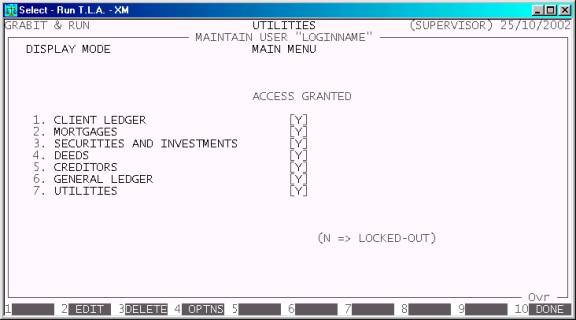
Note that the current user-code is displayed at the
top of the screen.
You are now in the DISPLAY MODE. In this mode you can move around the menu structure.
This program mimics the menu program in that all the menu options appear, but
unlike the real menu program, pressing a number will not actually initiate the
option. Instead, the program displays the menu and also displays a Y or N against each option. Those
that have an N, are not available to the
current user.
To exit from this screen, press <ESC>. The user will have been created and any attributes
set will become effective immediately.
DELETING A USER
If you wish to delete this user press <F3>. This will completely delete the user from the
system. Make sure that the user is not currently logged-on. Once a user-code is
deleted, the user will not have access to T.L.A. The user can only be
reinstated by totally recreating their code.
Setting User Options
The first step to customising a userís attributes is
to set-up the options for the user. Press <F4>. The following questions
will be asked:
ASK
TO PRINT AUDIT-TRAIL ON EXIT? .............. (Y+/N-) [ ]
This question is only relevant if you have chosen to
print the audit trail, SECTION 7.1.2. New
users are flagged with an N here. This means that, by
default, they will not be offered the opportunity to print the audit trail when
they exit the MAIN MENU. It will
still possible for such a user to print the audit trail via the UTILITIES MENU unless you separately
lock out this option from them. To be asked for the audit trail print on exit,
enter Y here. Usually, only senior
operators will be given the option to print the audit trail.
NUMBER
OF SECONDS BEFORE DISPLAYING MENU? ...... (Y+/N-) [ ]
This option allows you to specify a delay when
moving through the menu programs. With todayís fast computers, this option is
normally set to zero, implying no delay. If you are using a slow display, eg
via a slow modem link, it might be preferable to have the menu not display
anything unless you pause for a number of seconds. You can thus set the delay
for 1 to 9 seconds, however delays of more than 3 seconds are not recommended.
Setting this option will cause the movement around the menu programs to be
faster (because the screen does not have to be updated) but the display might
become confused. This option only affects the MENU program and is rarely used. Before you set this option,
consult your dealer.
SUPPRESS
BEEP IN AUTO-SEARCH? .................. (Y+/N-) [ ]
Before T.L.A. goes into an auto-search it beeps to
warn you that you have not entered a correct code. (Auto-search can be turned
on or off in the SYSTEM OPTIONS, see
SECTION 7.1.2.)
Some users find this beep useful and some find it annoying. You can choose here
whether an individual user will get a beep or not.
SUPPRESS
BEEP IN WARNINGS? ..................... (Y+/N-) [ ]
Certain conditions cause T.L.A. to display a warning
message. Most of these also cause the computer to beep. Some users find this
beep useful and some find it annoying. You can choose here whether an
individual user will get a beep or not.
SUPPRESS
BEEP IN ERRORS? ....................... (Y+/N-) [ ]
Certain conditions cause T.L.A. to display an error
message. Most of these also cause the computer to beep. Some users find this
beep useful and some find it annoying. You can choose here whether an
individual user will get a beep or not.
ALLOW
THIS USER TO INITIATE AUTO-JOURNALS? ..... (Y+/N-) [ ]
At the beginning of the day, T.L.A. checks to see if
there are any auto-journals to be applied. This is checked once a day by the
first user to log in, if that user is SUPERVISOR
or if the current option is set to Y
for that user.
There is a delay while T.L.A. is checking for auto-journals. This delay might confuse
certain users, so the option is set to N by default. Then you can
set it to Y for any of your more senior
employees or just leave it till you log in as SUPERVISOR.
ALLOW
SUPERVISOR OVERRIDE RIGHTS? .............. (Y+/N-) [ ]
There are certain functions that can only be entered
by SUPERVISOR. These include,
overriding stop-payments, re-initialising last-journal dates, etc. You can also
allow other trusted employees the right to enter these functions if you reply Y here. Note that only SUPERVISOR
can update this field so SUPERVISOR
still has ultimate control.
ALLOW
THIS USER TO UPDATE NOTES IN ENQUIRIES? .. (Y+/N-) [ ]
Normally, Client, Creditor, etc. notes can only be
updated in the MODIFY option. If you
also wish to allow updates in ENQUIRIES,
enter Y here. Note that this can be
set user-by-user and that the SUPERVISOR
automatically has this feature enabled.
ALLOW
TFN ENQUIRIES THROUGH CLIENT MAINT.? ..... (Y+/N-) [ ]
Most users on the system should not have access to
private information such as TFNís. To excluded this user, enter N here.
ALLOW
NEW BILL NUMBERS THROUGH THIS USER-CODE? . (Y+/N-) [Y]
This is only relevant if you are using the BILL-BOOK
option. This allows you to restrict the ability to create new BILL-NUMBERS
to a select set of users.
To exit from this screen, press <F10>. If you press <ESC> instead, you will also
leave this screen, but no update will have occurred.
Locking out an option
You may move around in display mode until you
display a screen that contains functions that you wish to lock out. Pressing <F2>. This will change you into the EDIT MODE. In this mode you are able to change the user's access to
the displayed menu options.
The screen will appear as follows:
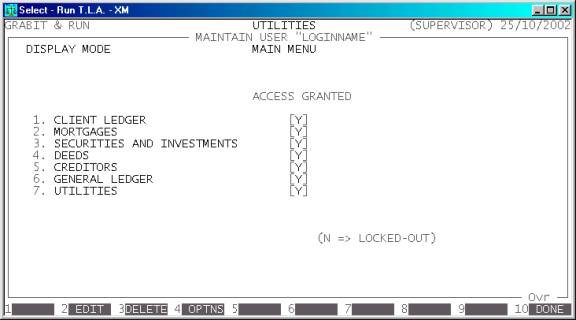
The options are:
Y+/N-††††† Each option has a yes/no switch on the same line. To
make the option available choose Y, otherwise choose N. Note that if you choose to lock-out an option which is itself a menu
option, the entire branch of the menu becomes unavailable to the user. Eg.
locking out CLIENT/TRUST REPORTS
will lock-out all ledger reports. If you wish to lock-out only some
reports, enable CLIENT/TRUST REPORTS
and then choose REPORTS in DISPLAY MODE, and finally, choose which
particular reports you wish to lock-out.
<F4>†††††† This will make all options on this screen available
to the user. Any locked options will be unlocked.
<F5>†††††† This will make all options on this screen
unavailable to the user. All options will be tagged as locked.
<F10>††††† This will save your changes and return you to the display
mode.
<ESC>††††† This will abort any changes you have made and return
you to the display mode.
If you wish to lock all options for a whole menu,
eg. all report options for CLIENT/TRUST transactions, it is
more efficient to lock the option on the previous menu. This will also have the
effect of not allowing the user to display the locked menu.
Leaving the User Maintenance Option
Having created the user, their options and
permissions, press <ESC> in display mode until you
have returned to the ENTER USER-CODE question. From here you may
either enter another user-code or press <ESC> to be returned to the SYSTEM UTILITIES MENU.